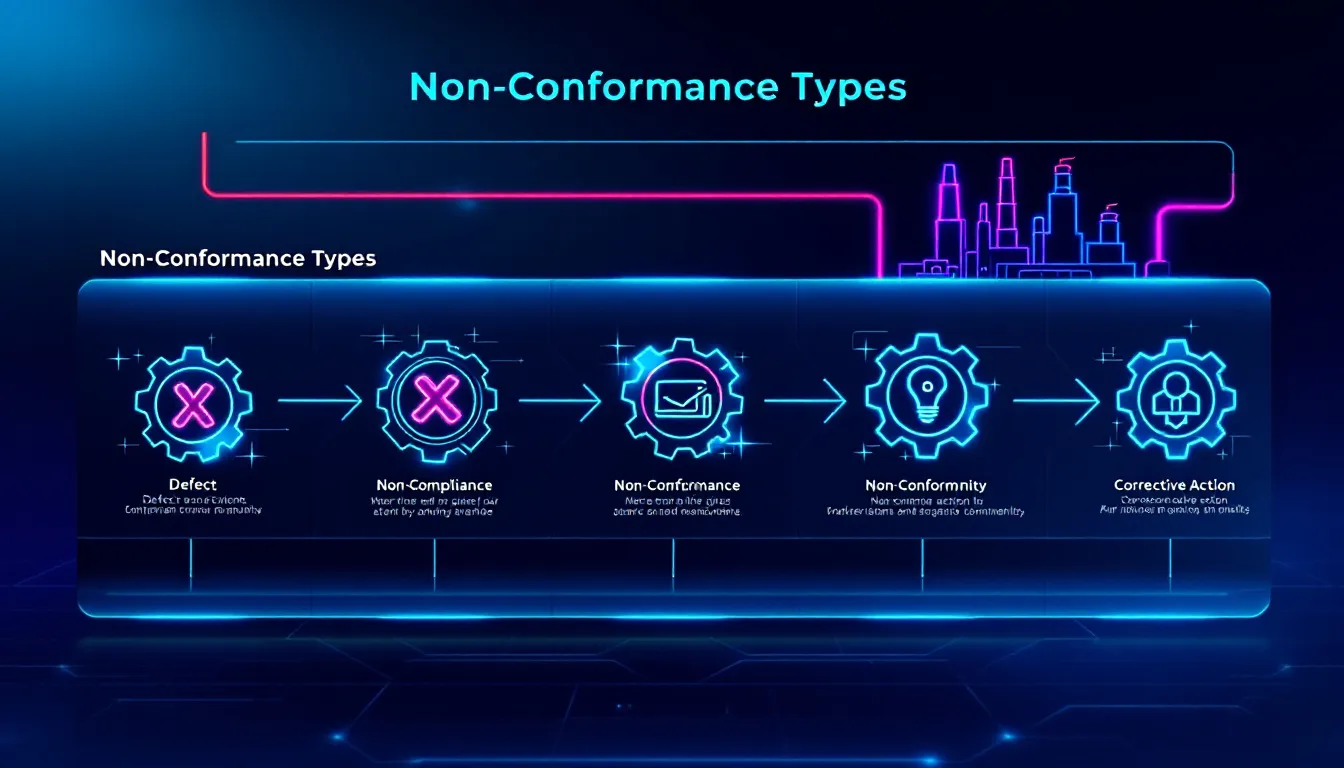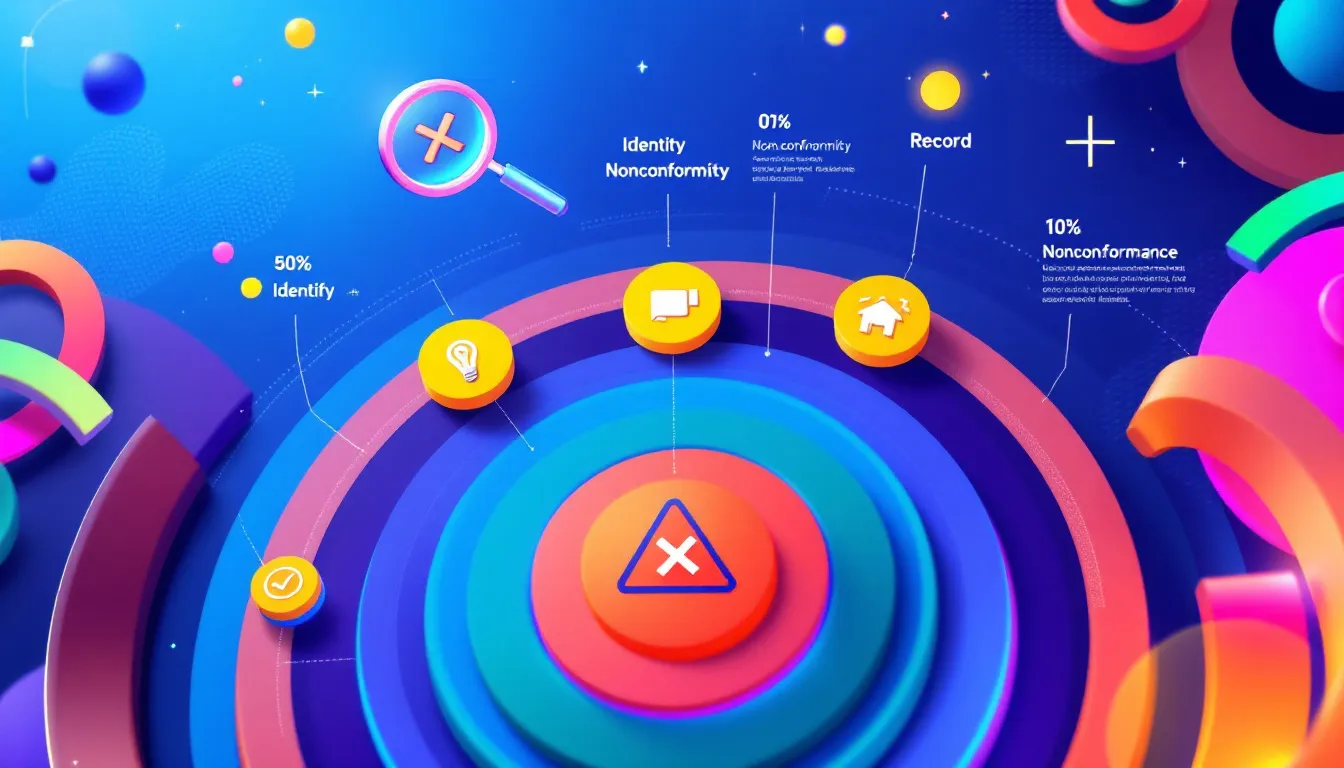Mastering the Non Conformance Management Process: Steps and Strategies
Efficient management of nonconformances is vital for upholding quality and regulatory compliance. The non conformance management process helps you identify, document, and resolve deviations from standards, ensuring continuous improvement and operational efficiency.
In this guide, you’ll discover the systematic steps to handle nonconformances and maintain high-quality standards in your organization.
Key Takeaways
-
Nonconformance management is essential to uphold product quality, compliance, and operational efficiency by systematically identifying, documenting, and addressing deviations from established standards.
-
Nonconformances are categorized as minor or major, with each type requiring tailored corrective actions and continuous monitoring to prevent recurrence and ensure quality management.
-
Utilizing QMS software enhances nonconformance management by automating processes, improving documentation, and facilitating compliance with regulatory standards through effective monitoring and employee training.
Understanding Non Conformance

Nonconformance refers to instances where a process or product fails to meet established requirements, often termed as non-conformities or NCs. These deviations can stem from various sources, including customer complaints, audits, or internal reviews. Nonconformances may result from failing to meet internal requirements, such as company-specific standards and procedures, as well as external standards. The repercussions of nonconformances are far-reaching, affecting product quality, compliance, and overall efficiency.
Nonconformances can decrease productivity and efficiency, significantly damaging a company’s reputation. Unaddressed nonconformances can escalate into severe financial and regulatory consequences, jeopardizing the business’s viability. This underlines the importance of having robust procedures in place for identifying, documenting, and correcting nonconformances to maintain high-quality standards.
Addressing nonconformities involves both fixing current issues and preventing future occurrences. This is a critical component of a quality management system, ensuring continuous improvement and adherence to quality requirements. Effective nonconformance management sustains product quality and compliance, safeguarding the company’s reputation and operational efficiency.
Types of Non Conformances

Nonconformances are generally classified into two main types: minor and major nonconformances. Minor nonconformances are isolated incidents that do not significantly affect product quality or safety. These might include minor deviations in the manufacturing process that are quickly corrected and do not impact the final product.
The company typically decides the criteria for classifying nonconformances as minor or major, based on its specific context, industry standards, and internal policies. The company typically decides the criteria for defining the severity of a nonconformance based on its specific products, services, and processes.
On the other hand, major nonconformities involve persistent issues that can significantly impact product quality, safety, or compliance efforts, including manufacturing defects and external regulations, as well as external event considerations. These can lead to operational disruptions and regulatory compliance quality issues, necessitating ongoing monitoring to identify non conformances and ensure deviation occurring quality standards are upheld, including potential failure mode analysis. Major nonconformities may require significant resources, effort, and time to correct.
Understanding these types helps in implementing appropriate corrective actions and maintaining quality management systems. The examples provided are not exhaustive and there is no implied priority among them.
Steps in the Non Conformance Management Process

The nonconformance management process involves several critical steps aimed at identifying and addressing deviations from established standards. The steps include:
-
Identification (for example, detecting a foreign object in a product, which is a common nonconformance in regulated industries)
-
Documentation
-
Immediate corrective actions
-
Root cause analysis
-
Developing and implementing corrective actions to address identified issues
-
Monitoring and follow-up
-
Non conformance process
This structured approach ensures that nonconformances are systematically managed and resolved.
Controlling nonconforming products is crucial in the nonconformance management process. Procedures to identify root causes and develop a corrective action must be implemented. Regular management reviews help identify potential nonconformance issues before they escalate, ensuring continuous improvement in quality management and manufacturing processes.
In life science companies and other regulated industries such as medical devices, managing nonconformances focuses on the severity of the issue and applicable regulatory requirements set by external governing bodies to ensure continuous improvement. This systematic approach not only addresses immediate problems but also helps in preventing future nonconformities and avoiding other legal ramifications.
Identification and Documentation
Identification, the first step in managing nonconformances, can be triggered by sources such as customer complaints, audits, or internal reviews. Once identified, comprehensive documentation is crucial for effective management. Documentation should include details such as the nature of the nonconformance, its type, date, location, responsible person, and potential impact.
A nonconformance report (NCR) documents specific details about the identified issue. Creating a formal nonconformance report (NCR) documents essential details about the identified issue, including its nature, location, date, personnel involved, and any immediate actions taken. A non conformance report template ensures consistent capture of all necessary details. Formally closing a nonconformance report documents the actions taken, ensuring transparency and accountability. Including actions leading to resolution in the nonconformity report clarifies the corrective efforts.
Immediate Corrective Actions
Immediate corrective actions are necessary to address the issue and prevent further impact on business operations when a nonconformity occurs, as there may be legal ramifications. A fast reaction is crucial to avoid disruption and mitigate associated risks. Recommendations may include stopping the production line and blocking affected products to prevent further impact.
Immediate measures often include halting production and isolating affected products to prevent further impact. Prompt corrective actions and an effective operating procedure should eliminate or reduce risks, ensuring smooth business operations.
Root Cause Analysis
Root cause analysis identifies the fundamental issues behind nonconformances. This thorough analysis enhances nonconformance management by ensuring underlying issues are addressed, preventing recurrence. Techniques such as the 5 Whys and Ishikawa diagrams are common tools for root cause analysis.
QMS software enhances collaboration among teams during root cause investigations. QMS software provides a centralized platform for data analysis and communication, aiding thorough and effective root cause analysis.
Developing and Implementing Corrective Actions
Developing and implementing corrective actions involves creating a detailed action plan with defined actions, the person responsible, and deadlines. The plan should include required actions, responsibilities, deadlines, and necessary resources for effective implementation.
Implementing corrective and preventive actions (CAPA process)addresses immediate issues and prevents future occurrences. Stakeholders can be notified about the new corrective and preventive action plan via a digital platform, ensuring alignment with corrective efforts.
Monitoring and Follow-Up
Monitoring the effectiveness of corrective actions ensures processes function properly and nonconformance is resolved. Effective monitoring reviews the outcomes of corrective actions and ensures compliance standards are met.
Follow-up and monitoring methods include internal audits, investigations, monitoring key performance indicators (KPIs), and ensuring action closure by stakeholders. Thorough monitoring and follow-up prevent nonconformance recurrence, maintaining compliance and quality standards.
Verification and Closure of Non Conformances
Verification and closure are critical final steps in the nonconformance management process, ensuring that all corrective and preventive actions have been successfully implemented and that the nonconformity has been fully resolved. During the verification phase, the effectiveness of the corrective and preventive actions is assessed to confirm that the root cause has been addressed and that similar issues are unlikely to recur. This step is essential for maintaining the integrity of the overall quality management system and supporting continuous improvement.
Once verification is complete, the closure process involves updating the nonconformance report with all relevant details, including the actions taken, outcomes, and any supporting evidence. Approval from relevant stakeholders, such as the quality manager, is required to formally close the nonconformance. This documentation not only provides a clear record for future reference but also demonstrates compliance with regulatory requirements and internal standards.
The quality manager plays a pivotal role in overseeing the verification and closure of nonconformances, ensuring that each case is thoroughly reviewed and that the management process is followed consistently. Effective verification and closure help organizations maintain high and uniform quality across all manufacturing processes, reinforcing the strength of the quality management system and driving ongoing improvement.
Preventive Measures to Avoid Non Conformances

Preventive measures are crucial for proactively preventing potential nonconformances. Regular internal and external audits and external audits ensure compliance with quality standards and identify opportunities for improvement. These audits identify real and potential nonconformances, allowing organizations to address issues before they escalate.
Continuous employee training keeps the team aware of the latest procedures and regulations, minimizing nonconformances. Employee feedback sessions can uncover knowledge gaps and highlight areas prone to nonconformance. Risk assessments in nonconformance management allow organizations to identify potential nonconformance areas and assess their impact.
A preventive approach enables organizations to address potential risks and mitigate costs associated with nonconformance. Preventive actions, regular internal audits, employee training, and risk assessments are strategies for preventing nonconformances. Predictive analytics in Quality Management Systems can identify trends in nonconformance data, aiding in risk management. Implementing preventive action is essential for effective quality management.
The Role of Employee Training in Non Conformance Management
Employee training is a cornerstone of effective nonconformance management, as it empowers staff to recognize, report, and respond to quality issues proactively. Well-trained employees are more likely to identify potential nonconformances early, document them accurately, and participate in implementing corrective and preventive actions. Comprehensive training programs should cover the entire nonconformance management process, including how to spot deviations, use documentation tools, and follow established procedures for corrective and preventive actions.
Automated training activities, often managed through QMS software, ensure that all employees receive consistent, up-to-date instruction tailored to their roles. This not only streamlines the training process but also helps organizations maintain compliance with evolving regulatory requirements. The quality manager is responsible for overseeing training initiatives, ensuring that every team member is equipped with the knowledge and skills needed to uphold product quality and support the overall quality management system.
Regular refresher courses and ongoing education are essential to keep employees informed about new procedures, standards, and best practices. By investing in robust employee training, organizations can significantly reduce the occurrence of nonconformances, enhance product quality, and foster a culture of continuous improvement.
The Importance of Internal Audits in Detecting and Preventing Non Conformances
Internal audits are a powerful tool for detecting and preventing nonconformances within a quality management system. By systematically reviewing processes, documentation, and compliance with internal and external standards, internal audits help organizations identify weaknesses or gaps that could lead to nonconformities. These audits provide valuable insights into the effectiveness of the management system and highlight opportunities for corrective and preventive actions.
The audit process, whether conducted by internal teams or external auditors, involves a thorough examination of procedures, records, and outcomes. Findings from internal audits are documented and used to drive improvements, ensuring that any identified nonconformances are addressed promptly and effectively. The quality manager is responsible for coordinating regular audits, following up on audit findings, and ensuring that corrective and preventive actions are implemented as part of the nonconformance management process.
Internal audits not only support compliance with regulatory requirements but also contribute to continuous improvement by fostering a proactive approach to quality management. By regularly evaluating and refining processes, organizations can minimize the risk of nonconformances, enhance product quality, and strengthen their overall quality management system.
Integrating Non Conformance Management into the Manufacturing Process
Integrating nonconformance management directly into the manufacturing process is essential for ensuring that quality issues are identified and addressed in real time. By embedding the nonconformance management process within daily operations, organizations can quickly detect deviations, document them accurately, and implement corrective and preventive actions without delay. This integration supports a seamless connection between the manufacturing process and the overall quality management system, ensuring that all nonconformances are managed consistently and effectively.
Standard operating procedures should include clear guidelines for identifying, reporting, and resolving nonconformances at every stage of production. The quality manager is responsible for overseeing this integration, ensuring that staff are trained, processes are followed, and that QMS software is utilized to streamline documentation and workflow management. Regular reviews and updates to the nonconformance management process help maintain its effectiveness and ensure ongoing compliance with regulatory requirements.
By fully integrating nonconformance management into the manufacturing process, organizations can reduce the frequency and impact of quality issues, improve product quality, and drive continuous improvement across all operations. This proactive approach not only safeguards compliance but also supports the delivery of high and uniform quality products to customers.
The Role of QMS Software in Non Conformance Management

QMS software automates documentation, audit trails, and centralizes records, aiding nonconformance management. These systems streamline nonconformance handling by utilizing automated reminders, notifications, and pre defined workflows. Automating alerts for due activities ensures responsibilities are not forgotten and tasks are completed on time. QMS software integrates all these aspects—nonconformance management, compliance, and process improvements—into a single platform. Cloud-based QMS solutions facilitate access to qms processes and nonconformance management tools from any location, improving efficiency.
Automating steps and minimizing human error, eQMS software platforms help reduce regulatory bodies noncompliance risks. QMS software supports compliance with regulatory standards such as ISO 9001:2015 and FDA regulations. Automated reminders and notifications accelerate the nonconformance resolution process. These systems also streamline employee training management by automating activities and establishing customizable learning rules.
Tailored quality manager and nonconformance management capabilities for life sciences organizations enhance overall quality management system in life sciences industries. Integrating QMS software helps organizations ensure compliance, maintain high-quality standards, and effectively manage nonconformances.
Implementing QMS software also helps organizations maintain and improve overall compliance.
Importance of Continuous Improvement in Non Conformance Management
Nonconformity management aims to prevent future nonconformities and continuously improve performance. Compliance in the nonconformity management process increases customer satisfaction and improves overall performance. Nonconformity management maintains high quality and compliance while promoting continuous improvement.
Customer feedback analysis can reveal trends and root causes of nonconformance, aiding proactive improvements. Regular process reviews ensure continuous improvement in quality. Emphasizing continuous improvement fosters a proactive culture where employees identify and resolve customer complaint issues and analyze data.
Engaging leadership in nonconformity management establishes a quality-driven organizational culture. Regular process reviews and commitment to quality enhancement help organizations stay ahead and maintain high and uniform quality standards.
Summary
To summarize, effective nonconformance management involves a structured process of identification, documentation, immediate corrective actions, root cause analysis, developing and implementing corrective actions, and monitoring and follow-up. Each step is crucial for maintaining compliance and ensuring continuous improvement in quality management.
In conclusion, mastering nonconformance management is vital for any organization aiming to uphold high-quality standards and regulatory compliance. By implementing the strategies discussed in this guide, you can transform nonconformance challenges into opportunities for growth and improvement. Remember, the journey to excellence is continuous, and every step you take towards better nonconformance management brings you closer to achieving your quality goals.
Frequently Asked Questions
What is nonconformance management?
Nonconformance management is the systematic approach to identifying, documenting, analyzing, and resolving failures in processes or products that do not meet established requirements. Nonconformities indicate gaps between desired outcomes and actual results, prompting corrective actions. This ensures compliance and improves quality within an organization.
What are the main types of nonconformances?
The main types of nonconformances are minor and major nonconformances. Minor nonconformances consist of isolated incidents with minimal impact, whereas major nonconformances involve significant issues that can adversely affect quality, safety, or compliance.
Why is root cause analysis important in nonconformance management?
Root cause analysis is essential in nonconformance management as it identifies the fundamental issues behind nonconformances, thereby ensuring that underlying problems are effectively addressed to prevent recurrence.
How does QMS software assist in nonconformance management?
QMS software significantly enhances nonconformance management by automating documentation, centralizing records, and streamlining processes with automated reminders and predefined workflows, leading to improved efficiency and compliance.
What are some preventive measures to avoid nonconformances?
To avoid nonconformances, implement regular internal audits, provide continuous employee training, conduct risk assessments, and utilize predictive analytics to identify trends. These measures collectively enhance compliance and operational efficiency.
Share this
You May Also Like
These Related Stories

QMS Software for Pharmaceutical Manufacturers

Top Strategies for Successful QMS Implementation


No Comments Yet
Let us know what you think